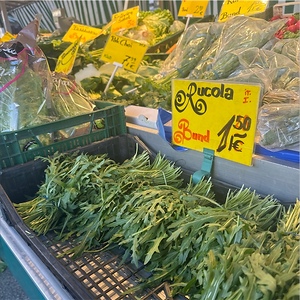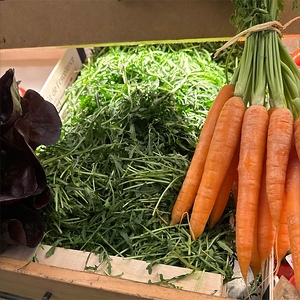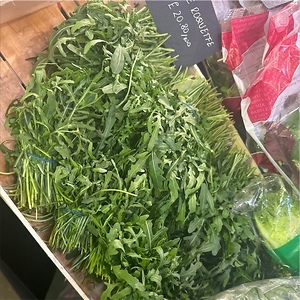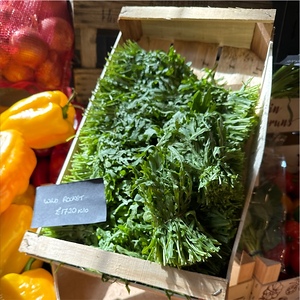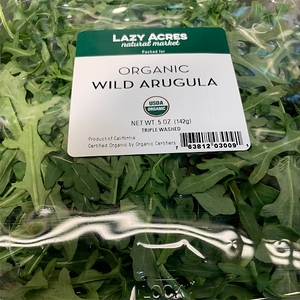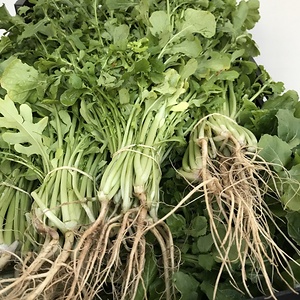

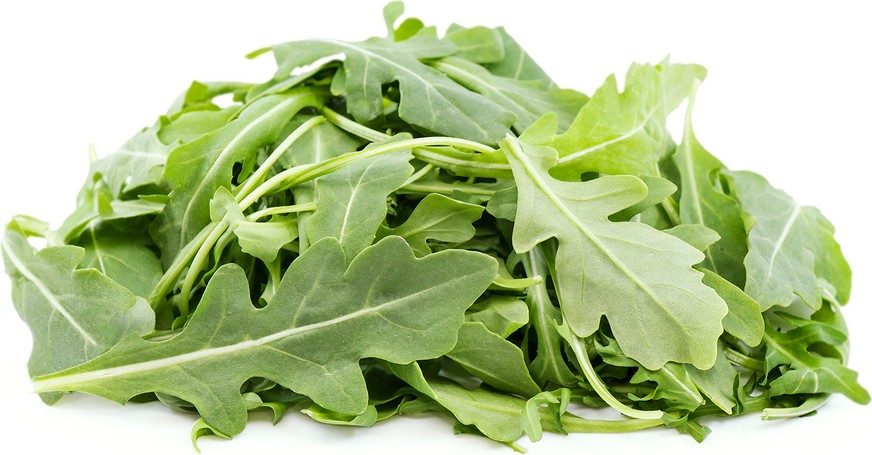
Wild Arugula
Estimated Inventory, bunch : 0
Description/Taste
Wild arugula consists of small, jagged leaves, averaging 7 to 20 centimeters in length, that grow in bunches surrounding slender, upright stalks with bright yellow flowers. The leaves are elongated, dark green, narrow, and deeply lobed with lightly serrated edges. The surface also bears prominent veining that connects into the central, pale green stem. Wild arugula has a crisp consistency with an intense, pungent flavor containing sweet and bitter notes of pepper, nuts, horseradish, and pine. It is important to note that the sharp, zingy taste of Wild arugula is more robust than common arugula and should be used sparingly in culinary dishes.
Seasons/Availability
Wild arugula is available in the spring through fall.
Current Facts
Wild arugula, botanically classified as Diplotaxis tenuifolia, is an ancient herb belonging to the Brassicaceae family. The peppery green is one of three main species of arugula cultivated for human consumption and is mainly found growing wild in the Mediterranean in open fields, along roadsides, and as a weed in home gardens. Wild arugula is also known as Roquette, Wild Rocket, Rauke, and Sylvetta and is used as a vegetable and herb in various culinary applications. The variety is common in Europe and Western Asia, but outside of its native range, the greens are regarded as a specialty cultivar found through select growers at farmer's markets. Wild arugula has also become a favored home garden variety, cultivated for its adaptability, fast-growing nature, and perennial attributes. The slender leaves provide a subtly sweet, peppery, and nutty taste, and the flavor is more potent than common arugula or Eruca sativa.
Nutritional Value
Wild arugula is an excellent source of vitamin K to help with wound healing and vitamin A to strengthen the immune system, protect against vision loss, and improve skin complexion. The greens also contain vitamin C to reduce inflammation, potassium to regulate fluid levels within the body, and calcium to strengthen bones. Beyond vitamins and minerals, Wild arugula is believed to contain glucosinolates, which are compounds that give the greens their bitter flavor and are said to help in disease prevention.
Applications
Wild arugula can be treated as an herb or vegetable in culinary applications and is best suited for both raw and lightly cooked preparations. The leaves can be harvested when young, containing a slightly sweeter flavor, or they can be gathered when fully mature, bearing a bitter, more pungent bite. When served fresh, Wild arugula can be tossed into salads, chopped and sprinkled over roasted meats, used as a topping over pizza, served as an edible garnish, or minced and mixed into dips, spreads, salsa, pesto, and dressings. Wild arugula can also be layered into sandwiches and quesadillas or served with fresh tomatoes and aged balsamic vinegar as a side dish. In addition to fresh preparations, Wild arugula can be stirred into pasta, soups, stews, and casseroles to lightly wilt the greens, or the leaves can be steamed and dressed in vinegar as a tangy accompaniment. When the variety is heated, the texture softens, and the flavor will mellow. Wild arugula pairs well with meats such as poultry, duck, beef, and veal, seafood, nuts such as walnuts, pine nuts, and almonds, summer squash, potatoes, mushrooms, radicchio, butter lettuce, tomatoes, cheeses such as mozzarella, parmigiano-reggiano, gruyere, and cheddar, and fruits such as pears, melons, grapes, and berries. Whole, unwashed leaves should be placed in between paper towels and kept for 2 to 5 days when stored in a sealed container in the refrigerator.
Ethnic/Cultural Info
Wild arugula grows freely across the Italian countryside, and many Italians fondly remember gathering the pungent leaves from wild plants growing in fields during the summer. The greens are primarily used as an accent in fresh salads, but they can also be mixed into pasta, rice, and potato dishes for added flavoring. Wild arugula is also cultivated on a small scale in Italy and is sold in neighborhood markets under the name Rughetta or Ruchetta. Hand-tied bunches of mixed greens are clearly labeled with or without Ruchetta to inform consumers of the strongly flavored leaves, and many of these bunches are incorporated into panzanella, a salad of chopped tomatoes, bread, onions, pancetta, olives, and cucumbers. On the island of Ischia off the coast of Italy near Naples, a liqueur known as Rucolino is also made of Wild arugula, bearing a spicy, sweet, and bitter flavor. The liqueur is made from citrus, spices, Wild arugula, and roots and was developed by the Savastano family using a recipe over 135 years old.
Geography/History
Wild arugula is native to the Mediterranean, Western Asia, and areas of Northern Africa and has been cultivated since ancient times. The variety was later planted in other regions of Europe, including England and Finland, and sometime during the 17th century, it was introduced along the East Coast of the United States through Italian settlers. Today Wild arugula has become naturalized in regions throughout Europe, the Middle East, Asia, Australia, South America, and the United States. The greens are primarily sold at local farmer’s markets or specialty grocers and can also be found growing wild or cultivated in home gardens.
Recipe Ideas
Recipes that include Wild Arugula. One



